Recently I had the opportunity to spend several days learning about the history and aesthetic of Bohus knitting. Bohus is a very particular niche of Swedish knitting, knitted at a tiny gauge with elaborately patterned yokes using angora-merino yarn that creates shaded effects of color blending that can’t be replicated with other kinds of yarn, and the color work can use as many as five colors per row with floats as long as 26 stitches. The bodies are knitted plain, usually with ribbing at the hem and cuffs, often using lambswool. The Bohus style is a closely controlled aesthetic that was created by its six designers between 1939 and 1969 under the unifying vision of its founder, Emma Jacobsson, and the ongoing quest to preserve its purity and authenticity is a reflection of its history.
Bohus Stickning was a cottage industry founded by Emma Jacobsson to provide the poverty-stricken families of Göteburg, Sweden, with an income source, following the world-wide economic collapse caused by the New York Stock Exchange crash of 1929. Emma Jacobsson was the wife of the governor of Göteburg in the 1930’s, which had previously been a granite-producing region until the switch from granite paving to asphalt eliminated its primary product. Emma was looking for the most lucrative possible cottage industry that could be done by the women of the families, and every woman knew how to knit. She wanted to create a product that would be extremely high-end and capable of competing with Paris couture so that when the people at the bottom of the chain of production, the knitters, were paid, they would be paid enough to save their families from starvation. There was no room for anything other than perfection in order to maintain the brand. The mystique of Bohus designs had to be protected from imitation and variation from outside, so all innovation had to be done in-house. The company shut down in 1969, but that guarding of its exclusivity has persisted.
Sometimes people admire something I’ve designed and knitted and ask me how much it would cost them for me to knit it for them. I look them dead in the eye and say, “five figures and your firstborn.” Even then I’m not sure that would be enough, because I am fortunate enough not to have to knit for money. Bohus knitters had no such good fortune, and what they were knitting was a nightmare scenario for a production knitter. They were farm women with little education and few options, squeezing in knitting late at night after tending their farms, children, and households, knitting patterns of extraordinary complexity at a minuscule gauge in bad light with bad needles, striving to meet Emma Jacobsson’s stringent standards for accuracy, fit, and impeccable finishing. The designers never designed anything to make to make the knitting easier for the knitter; it was always all about fashion and exclusivity, because that was the brand. If it wasn’t perfect, it wasn’t Bohus.
When Bohus Stickning folded its tent, a lot of the knitters never knitted again, and who could blame them? Knitting under those conditions would tend to suck the joy out of the craft. But when people aren’t getting paid to do something arduous, it turns into fun. So now, 50 years after the last Bohus garment was made by the Swedish production knitters, we have recreational knitters with disposable income who pay considerable sums for kits from the one place in the world that sells the authentically recreated patterns in the intended yarn. I’m not sure there’s a style of knitting that’s more complicated. Andean or Baltic traditions might be solid competition, but for sure they’re neck-in-neck with Bohus. There haven’t been any new designs for 50 years, but Bohus enthusiasts gladly knit the old patterns, pleased to line up in their Blue Shimmer pullovers next to all the other people wearing their Blue Shimmer pullovers as a badge of their precision, persistence, and fortitude. There really aren’t more beautiful patterns, or better quality materials, than what they get from the AngoraGarnet kits, and they deserve to be done as accurately as possible. I myself bought a kit for a Bohus hat and knitted it exactly according to the pattern, give or take a few stitches that didn’t come out even. It’s a beautiful hat and I don’t think I could have improved upon the design, but I had knitted a beautiful hat that was almost exactly like all the other beautiful hats that had been knitted from this kit. (I deviated from the pattern by finishing it with an improvised stranded pattern that was consistent with the character of the design, but it wasn’t the plain black center that the pattern called for.) The result, which is lovely, displayed my ability to count rather than my originality.
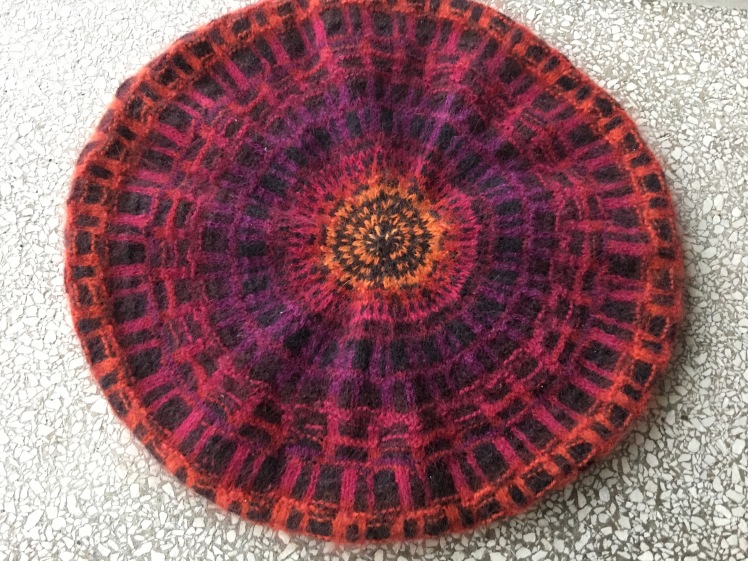
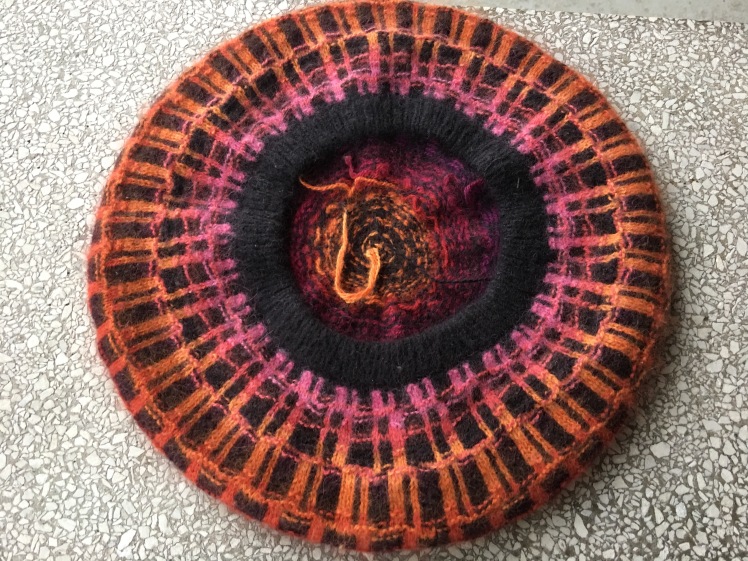
Much as I admire Bohus knitting, it really isn’t my style. As I have said in other posts, I am put off by doing lots and lots of plain stockinette. In fact that’s why I bought my knitting machine. As it happens, that’s why another of the knitters likewise took up machine knitting, with excellent results. Betty hand-knitted the yoke of her Gul Eld kit, top down, then machine-knitted the body and sleeves from the bottom up using a Knit Leader, a device that automatically spared her the need to do math. I don’t know how they work. There was still a lot of trial and error involved in joining the pieces so that they hung properly. One might think that using a knitting machine is the easy way out, but I’m here to tell you it’s never easy. If you’re lucky and things go well, it’s quick. But it’s never easy.

One of the irreplaceable elements in the unique look of Bohus design is the materials. Sometimes people play with Bohus color-blending techniques, like the use of purl bumps using heavier yarn that lacks the halo of the angora-merino mix, and it doesn’t work. But it is possible to make successful substitutions. Another of the knitters at this event, Laura, was knitting a Bohus pattern for a good friend who is mildly allergic to angora. She used a bit of the angora-merino yarn for some of the color work in the yoke in order to achieve the blurry color blending that gives the pattern its name, “Gray Mist,” but she was knitting the body and the outer strata of the gradient in the yoke using Shibui Cima, an alpaca-merino mix with the same heft as the prescribed yarn. It’s a different effect from the original, but it’s beautiful. Laura chose grays that flow out of each other naturally and logically, with a bit of crispness and definition that is not a quality of the original but is a different and desirable effect.

Bohus is beautiful, but it doesn’t inspire me enough to pay a ton of money for a kit that requires excruciating knitting, then for me to knit it beautifully, just to end up with a garment that looks like all the other beautifully knitted garments that have been made from that kit over the years. I’m perfectly capable of knitting at a minuscule gauge, with four or five colors per row, and combinations of knit and purl stitches in yarn I can barely see, but I aspire to more than technical achievement. I want to make something that gives me new insight into the relationship between color and context, shape and light, evocation of forgotten experience, as well as garment shapes that I actually like wearing, rather than the constrictive tailoring of a bygone era. So I studied the lovingly recreated Bohus garments arrayed before me and picked out the elements that might be applicable to my aesthetic. Bohus gradients are the design element that have the most to say to me. Their gradients often use many shades of the same hue, and the progressions are generally limited to the same color family.

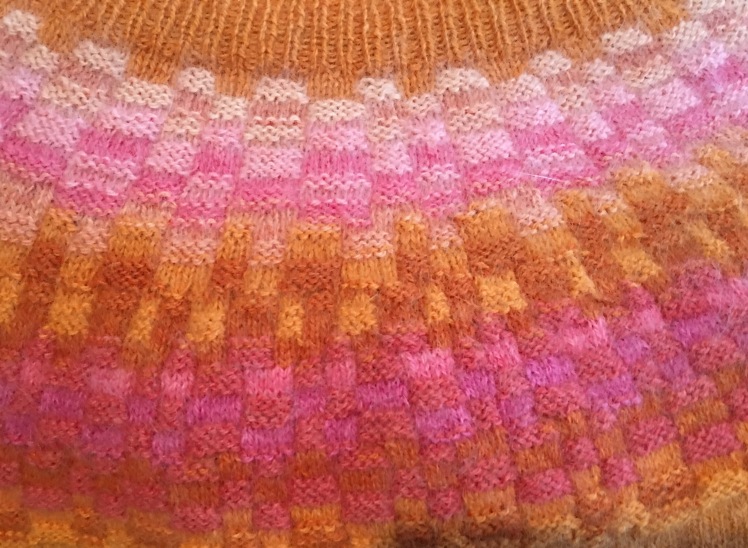
As I’ve said, I think the materials are the primary irreplaceable element in producing the gradient effects that are my favorite aspects of Bohus designs, and the “grabbiness” of the angora-merino blend makes it possible to have very long floats between one stitch of a color and its next usage, without having to twist the yarns. The halo of the angora-merino yarn blurs the edges between colors. I am very fond of the low contrast juxtapositions, not only of colors in similar color families but also of colors in different families whose value is similar.


High chroma colors are brightened by the use of related low chroma colors, and helps the darkest color glow out of its surroundings. I like the way the color progressions start with the lower-value shades and then crescendo with the high-value shades and then descend again. Another characteristic that pleases me quite a lot is the way Bohus uses grayed-down versions of bright colors, which then makes the bright color even brighter.
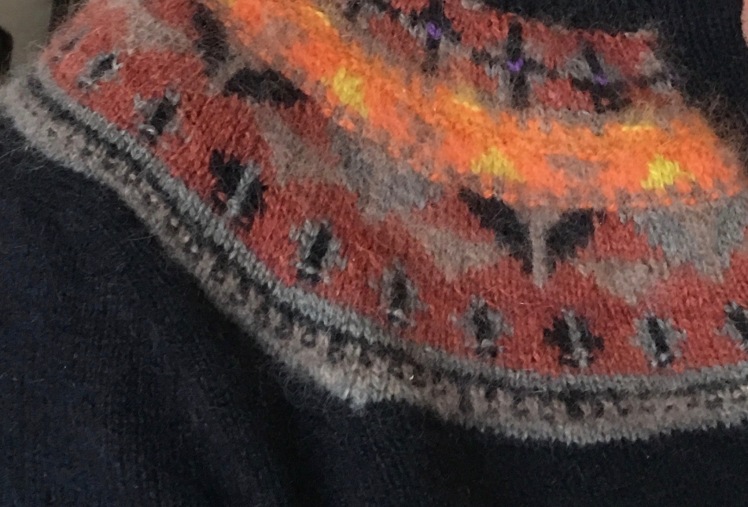

Finally, in this cursory listing of the design features that make Bohus distinctive, I have to mention purl bumps, which are so characteristic of Bohus that whenever someone wants to make something “Bohus-inspired,” there will always be some purls in there. The disruption to a smooth fabric that the purls provide throws the light into different directions, which adds nuance, but they also are an important tool in color blending because when the purl is knitted in a different color from the yarn of the previous row, the two colors come together in one stitch. They are also used to outline shapes. Sometimes the effect is to scatter 1,000 points of light throughout the surface of the knitting.


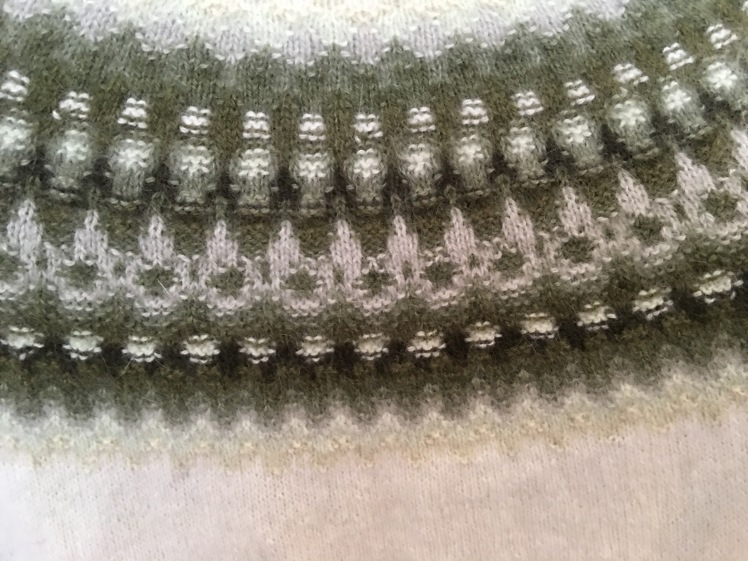

The work that appears in the post’s featured photo was knitted by Donnie Statzer and was photographed with his permission.

The details are so beautiful so intricate. Regards patricia
LikeLike
It’s definitely not your quick&easy knit!
LikeLike
I love reading your blog! I learn so much about knitting and color from your posts. Thanks for this great piece!
LikeLike
Thanks so much, Laura! I’m glad it’s interesting!
LikeLike
Great post Abby. It seems a shame that Bohus is so rigid. It looks frumpy to me, when with a little nod to the modern, it could look stylish again. Things that don’t develop die out after time. It seems a pity that Bohus seems stuck, like a fly in aspic.
LikeLike
I think you’re right, Gwen! It did seem that the only updates the guardians of the flame approve of are a bit of patterning at a cuff or maybe waist shaping in a plain stockinette body. To me, the format desperately needs someone to play with the colors and create new shapes in the patterning, while working with the design elements I have pointed out.
LikeLike